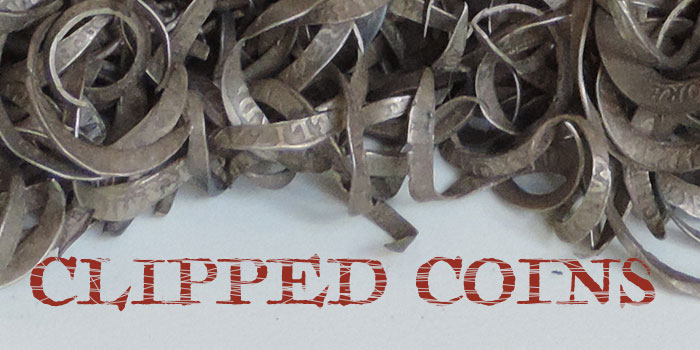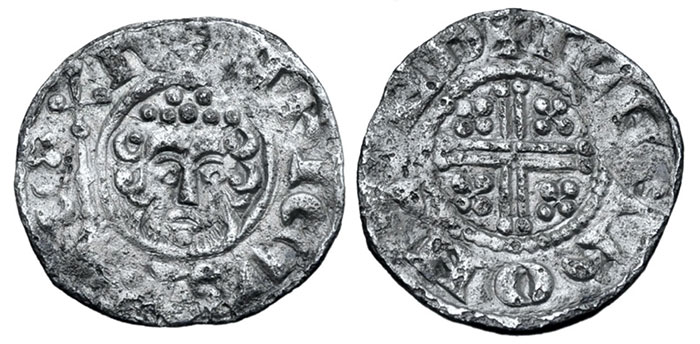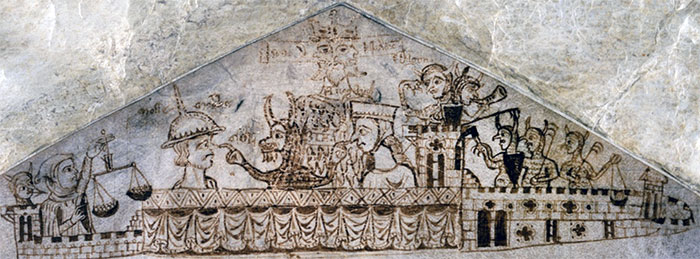
By Tyler Rossi for CoinWeek …..
Money equals power, and a ruler’s success often hinges on control of that power. The stability of a monetary system can reinforce a ruler’s right to rule; conversely, an unsound and vulnerable coinage can lead to disruptive social and economic issues.
As a result, medieval authorities, much like their modern counterparts, focused on their currency’s health and reacted harshly toward any and all negative actions taken against the coins that might reflect poorly on the ruler. This emphasis was clearly demonstrated by the 13th-century English cleric Henry de Bracton who argued that the worst available punishments must be reserved for “money counterfeiters, as well as for those who make bad money out of good … the clippers of coins” (Rokeah, 95).
Coin clipping?
Simply put, clipping is the “physical removal of metal” from the edges of coins by either shaving them with a knife or other such implements or cutting pieces off with shears (Stahl, 169). Interestingly, evidence exists that shows counterfeiters sometimes clipped their own fake coins in order to make their counterfeits appear more genuine. Occasionally a hoard of clippings will be discovered providing additional proof of this practice. One of the most important clipping hordes was unearthed in early 1972 in the county of Derbyshire, England and later acquired by the Derby Museum (image 1). While modest compared to other coin hordes, this discovery, and others like it, provides proof of the scale and pervasiveness of medieval coin clipping.

The practice of clipping continued into the late 16th and early 17th centuries until the development of uniform milled coins with repeating patterns on coin edges (V. Allen, 28-9). This feature instantly made clipping impractical because anyone could easily tell that the coin had been altered.
While counterfeiting definitely posed a real danger, it required a certain level of skill and sophistication that greatly reduced the number of passable pieces put into circulation. A forger would need either the ability to carve accurate dies or the opportunity to steal official sets, prepare the planchets, and then strike the fake coins. Clipping, however, required only a pair of sharp shears, a steady hand, and a “measure of self-assurance” (Kleineke, 219).
Additionally, the costs involved with forging coins were quite substantial as the forger needed to acquire enough raw metal and the equipment to mint the coins. In contrast, clipping coins proved to be an essentially free endeavor because after clipping the coins they could be recirculated, providing the individual with a 100% profit. The only downside came if caught since the authorities viewed clipping as theft.
A wider macro-effect of clipping was that gradually the nation’s coinage as a whole would become underweight, and as this process continued, both general confidence in the coinage and the value of full-weight coins would decline.
In fact, clipping proved so pervasive that an English royal survey conducted during 1247 estimated that the majority of circulating coins had been reduced by 1/3 their official weight (Rokeah, 84). Due to the surprisingly high quality of record keeping in medieval England, the activities of specific individuals can actually be traced. Extant records reveal a Bradford-in-Somerset merchant supposedly clipped almost 120 ounces of gold in 1414 from full-weight coins (Kleineke, 218). Though an extreme case, 120 ounces was a massive amount of gold for a private citizen at the time; many common people would clip a few shavings off silver pennies in an attempt to make a little extra money.
After centuries of having their silver pennies clipped, the British monarchy decided to make a change. An attempt to foil clippers can be seen on the pennies themselves. In 1247, King Henry III ordered a new silver penny design. These so-called “Long Cross” pennies incorporated a large cross that “reached the very edge of the coin” and would clearly show if the coin had been tampered with, as clippings would cut off parts of the design and not simply excess flan (Rokeah, 84). The design changes on the silver penny can be seen in images 2 & 3.


Due to their generally high precious metal content, simplistic designs, and manufacturing techniques, medieval coins proved incredibly vulnerable to counterfeiting and clipping. Consequently, in typical medieval fashion, governments imposed draconian punishments for tampering with coinage.
In early 14th-century Venice, a counterfeiter or clipper could be sentenced to the “loss of his right hand and right eye, and banishment”. Simultaneously “The Officials of Clipped Grossi” were created to search out clipped grossi, 98.5% pure Venetian silver coins, and bring the perpetrators to justice (Stahl, 169). By 1359, however, the clipping of Venetian coins reached a rate unacceptable for city officials and the Doge. In a demonstration of the importance of this issue, officials condemned the practice of clipping as a “sin abominable to God and the world and in great contempt of the Doge” (Stahl, 170).
By incorporating references to sin into a monetary crime, these officials clearly reveal the links between money and power, precious metals and divinity, and coins and the ruler. Venice then moved to increase the punishment for a man convicted of clipping to having both eyes removed, the right hand amputated, banishment, and a fine of 1,000 lire. For a woman, the punishment remained a life sentence (Stahl, 170).
Of course, not only medieval England and Venice fell victim to clipping. “False, clipped, and foreign coins” (Sargent & Velde, 135-6) plagued the contemporary French economy, which in part prompted an economic collapse with similar economic ramifications appearing in England.
This economic instability proved to be an enduring effect of clipping and counterfeiting, and as with numerous other problems, medieval society blamed their local Jewish populations. This suspicion became so prevalent that court case records from 1280 show that Henry of Cant was accused of clipping solely because “Jews frequented his house” (Rokeah, 86). As an example of “contemporary anti-Semitism”, this was unfortunately not unusual across Western Europe (Rokeah, 83). Additionally, the English crown set up a new parallel justice system for Jews who were both the victims of and accused perpetrators of monetary crimes: the Exchequer of the Jews (Rokeah, 85). The Exchequer of the Jews is depicted in what most scholars consider the first anti-Jewish caricature in Europe.

Those in positions of power knew that Jewish people did not constitute the majority of individuals clipping coins. Regardless, as multiple court cases from the early 1290s show, Jews revived dramatically harsher punishments than their fellow Englishmen and foreigners (Rokeah, 86). In 1278, 600 Jews were jailed on “charges of clipping”, and in London, 269 were killed and 148 Jews lost all of their possessions (Allen, 374). Interestingly, the official anti-Jewish sentiment in England shifted by May 1279, and an official court document states that “all the Jews charged, indicted and convicted of clipping the king’s money have now been punished with death, and certain of them have forfeited all their goods and chattels . . . and are imprisoned during the king’s pleasure” (Rokeah, 88). This is more likely an act of self-assurance than a factual statement. It is important to note, though, that this statement was taken from an official document and certainly does not reflect the attitude of common people, who certainly retained their anti-Semitic views and falsely believed that there were still guilty Jewish people free and actively interfering with the nation’s coinage.
Farther east, however, clipping may have been employed by state officials or private citizens as a method of “readjusting coins to various denomination” (KOTOWICZ & ŚNIEŻKO, 221). This theory has been centered mainly on Groschen minted in the Kingdom of Poland in the 13th-14th centuries of which two examples were uncovered during excavations at the medieval hillfort in Sanok – Biała Góra, a small town in southeastern Poland. Włodzimierz Bagieński, a notable Polish numismatist, associated two clipped groschen coins with a half-groschen minted under the same ruler, as they “correspond in terms of their weight and diameter” (KOTOWICZ & ŚNIEŻKO, 229). Therefore, Bagieński posits that the clipping served as an effort to change the value and denomination of the coins; this is similar to the phenomenon of cut English hammered coins where individuals would take a coin and cut it into halves, quarters, or some other even fraction.
Cutting coins also led to the famous Pieces of Eight popularized today by pirate movies where a Spanish milled dollar would be cut into eights and used as a smaller denomination in everyday transactions.
The Ukrainian scholar Andriy Krizhanivs’kiy goes one step farther and theorized that older groschen coins form rulers like Wenceslaus II, John of Luxembourg, and Charles IV may have been clipped to the weight of the same denomination from King Wenceslaus IV. In this instance, clipping is logical since the earlier coins contained a large quantity of higher-grade silver, so by cutting them down their value would be closer to the lower fineness of the later coins (KOTOWICZ & ŚNIEŻKO, 231).
Despite the evidence that medieval states occasionally employed clipping, the practice proved a lasting thorn in their side. In an attempt to discourage clipping, the governments attached religious imagery and bigotry onto their coinage while instituting draconian punishments for the guilty parties. Unfortunately, due to the decentralized nature of medieval states and how easy it was to clip a coin, the practice continued until technological advancements rendered it impractical.
* * *
References
Allen, M. Mints and Money in Medieval England. Cambridge University Press. 2012.
Allen, V. “When Compensation Costs an Arm and a Leg“, Capital and Corporal Punishment in Anglo-Saxon England. J. P. Gates (Ed.). Boydell & Brewer; Boydell Press. 2014. 17–33.
Kleineke, H. “The prosecution of counterfeiting in Lancastrian England“, Medieval Merchants and Money. M. Davies & M. Allen (Eds.). University of London Press. 2016. 213-226.
KOTOWICZ, P., & ŚNIEŻKO, G. “Clipped Prague groschen of John of Luxem”, Notae Numismaticae/Zapiski Numizmatyczne XI. 2016. 221–242.
Rokeah, Z. E. “Money and the hangman in late-13th-century England: Jews, Christians and coinage offences alleged and real (Part I)”, Jewish Historical Studies 31. 1988. 83–109.
Sargent, T., & Velde, F. “Medieval Coin Shortages“, The Big Problem of Small Change Princeton University Press. 2020. 131–138.
Stahl, A. M. “Coin and Punishment in Medieval Venice“, Law and the Illicit in Medieval Europe. R. M. Karras, J. Kaye, & E. A. Matter (Eds.). University of Pennsylvania Press. 2008. 164–179.
* * *




